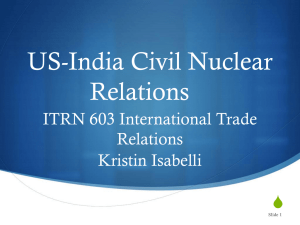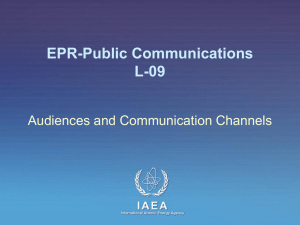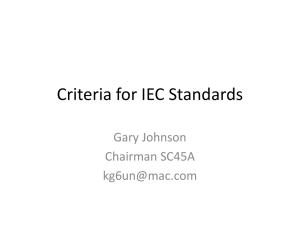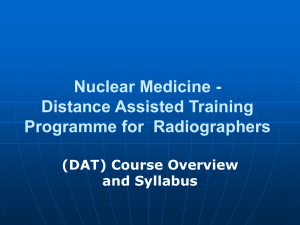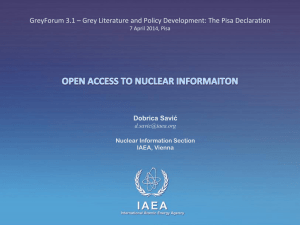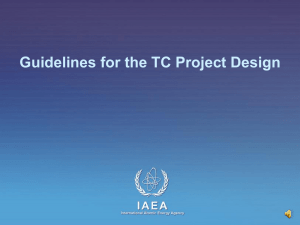IAEA
advertisement
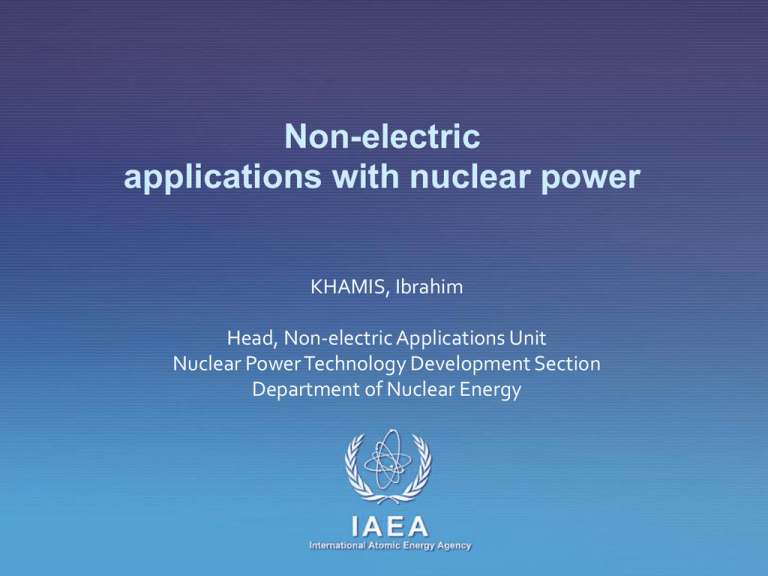
Non-electric applications with nuclear power KHAMIS, Ibrahim Head, Non-electric Applications Unit Nuclear Power Technology Development Section Department of Nuclear Energy IAEA International Atomic Energy Agency Contents Introduction to cogeneration Non-electric applications & Nuclear energy Status of major non-electric applications IAEA support for non-electric applications Conclusion IAEA What is Cogeneration & Multi-generation? Q Nuclear Reactor W Efficiency Matters!: Q W 1 W 2 ...... WN Fuel IAEA 3 Why cogeneration with nuclear? IAEA What is Non-electric applications? It is the use of nuclear power partially or fully for the production of heat (i.e. process steam) required for such applications: • Seawater desalination • Hydrogen production • District heating • Process heat for Industry: Petrochemical, refineries, oil sand/shale oil recovery, syn-gas production (coal-quality improvement), metal production (steel, iron, Aluminium..etc), glass and cement manufacturing..etc. IAEA Current status of nuclear power? Transport Electricity Sectors of global energy consumption Heat There is a big market for non-electric applications IAEA Non-electric Applications & Nuclear Energy The wide “spectrum” of current reactors can cover all applications IAEA Facts on non-electric applications with nuclear power Less than 1% of heat generated in nuclear reactors worldwide is at present used for non-electric applications. Potential: 340 units (1000 MWth) for district heating, 150 desalination, 240 for process heat, 600 for hydrogen Proven technology: with 79 operative reactors and 750 reactor-years experience: 1956: Calder Hall plant in UK provided electricity and heat to nearby fuel processing plant 1963: Agesta NPP in Sweden provided hot water for district heating to a suburb of Stockholm 1972: Aktau in Kazakhstan provided heat and electricity for seawater desalination to supply 120 000 m3/day fresh water for the city of Aktau 1979: Bruce in Canada heat to heavy-water production and IAEA industrial & agricultural users Advantages of non-electric applications using nuclear energy • Improve NPP efficiency (Energy saving): • Recycling of waste heat • Rationalization of power production (use of off-peak) • Improve the value of heat (use low-quality steam) • Improve economics of NPPs (Better Revenue due to): • Better utilization of fuel • Sharing of infrastructures • Production of more than one product (cogeneration) • Sustain the environment (keep Clean & reduce): • Consumption of fossil fuel to produce energy for CO2 non-electric applications • Impact due to all above (compared to two standalone plants) IAEA IAEA International Atomic Energy Agency Drivers for cogeneration Improve economics Meet demand for energy-intensive non-electric products (desalination, hydrogen,…etc). Secure energy supply for industrial complexes Accommodate seasonal variations of electricity demand Match small and medium electrical grid with available large-size reactors IAEA IAEA International Atomic Energy Agency Harnessing waste heat: PBMR for desalination Waste heat: Heat extracted from NPP with no penalty to the power production Using reject heat from the pre-cooler and intercooler of PBMR = 220 MWth at 70 °C + MED desalination technology Desalinated water 15 000 – 30 000 m3/day Cover the needs of 55 000 – 600 000 people IAEA Waste heat can also be recovered from PWR and CANDU type reactors to preheat RO seawater desalination Improvement of economics 10% of 1000 MWe PWR for desalination To produce 130 000 m3/day of desalinated water using 1000 MWe PWR Total revenue (Cogeneration 90% electricity +10% water): Standalone MED RO Electricity 7166 M$ 6771 M$ 7062 M$ Water 0 888 M$ 672 M$ Total 7166 M$ 7660 M$ 7700 M$ +7% +7.5% Using MED: • Easier maintenance & pretreatment • Industrial quality water IAEA Using RO : • Increased availability • No lost power as in MED • Using waste heat to preheat feedwater by 15oC increases water production by ~13% Improvement of economics with small desalination plants ~ 3% of total steam flow Nuclear PP 1000 MWe 125 MW(th) Steam extracted at 150 ºC after it has produced 55% of its electricity potential. MED - TVC GOR=10 150 ºC 50,000 m3/d 3% x 45%= 1.35% more steam needed in order to compensate the power lost • Cheap nuclear desalination Fuel cost ~ 15% of total electricity costs IAEA Source : Rognoni et al., IJND 2011 Better economics during off-peak power Hydrogen production Conventional Electrolysis (> 1000 kg/day) $/kg 4.15 Dedicated nuclear HT Steam Electrolysis plant $3.23 Off-peak grid electricity ($0.05/kW hr), HTSE $2.50 Large-scale Steam Methane Reforming $1.5 – 3.5 directly dependent on the cost of natural gas, no carbon tax IAEA 16 Nuclear Desalination • Reactors: 13 Aktau, Kazakhstan • Countries with experience: 4 • Total reactor-years: 247 Demonstration Projects Ohi, Japan India The 6,300 m3/d MSF-RO Hybrid Nuclear Desalination Plant at Kalpakkam, India, consists of 4,500 m3/d MSF plant and 1,800 m3/d SWRO plant, Pakistan MED thermal desalination demonstration plant of capacity up to 4,800 m3/d at KANUPP Korea Constructing a one-fifth scale SMART-P with a MED desalination unit in parallel with the SMART nuclear desalination project IAEA Nuclear Desalination Characteristics • Sound technically and economically • Available experience • Cogeneration issue IAEA Issues and Considerations • Need of Potable Water • Cogeneration: Nuclear heat and/or electricity • Co-location & Sharing of facilities and services (NPP & ND) • Innovations to make ND more viable Routes for Nuclear-Assisted H2 Production IAEA Hydrogen production using nuclear power • Current nuclear reactors: Low-temperature electrolysis, efficiency ~ 75% Off-peak power or intermittent • Future nuclear reactors: High-temperature electrolysis, efficiency ~ 95% Thermo chemical splitting, efficiency ~ 95%: IAEA Sulfur- Iodine cycle. Sulfur-Bromine hybrid Cycle cycle Copper Chlorine cycle District heating Technical features: Heat distribution network • Steam or hot water 80-150°C • Typical distribution 10-15 km District heat needs: • Typically up to 600-1200 MWth for large cities Annual load factor < 50% IAEA Characteristics: • Well proven: Bulgaria, China, Czech Republic, Hungary, Romania, Russia, Slovakia, Sweden, Switzerland and Ukraine • Usually produced in a cogeneration mode • Limited in applications District Heating Finland Russian Federations Switzerland IAEA Industrial process heat applications Examples: • Enhanced brown coal quality • Coal Liquefaction • Coal Gasification • Enhanced oil recovery • Example of future nuclear application - CANADA • Replace burning of natural gas for mining oil sands Steam Chambers • Experience: Canada, Germany, Norway, Switzerland, and India Cap Rock (shale & glacial t ill) 250m thick 40m 2yr 5yr 6mo 6mo 8yr 10yr • Main Requirements: • Location close to user • High reliability IAEA Unrecovered Heavy Oil ~ 200m ~ 1 kilometer Steam Assisted Gravity Drainage Enhanced oil recovery Path ways for Enhanced oil recovery: Exploitation of Heavy oils Reserves Recovery of nature and de-graded oil fields Production of Clean fuels and syngas from heavy sour crude oil and refinery tars /dirty fuels) IAEA Challenges for non-electric applications Disparity between characteristics of nuclear reactors & heat markets : Reliability & availability: no unexpected outages & Max availability Large vs small NPPs (industrial park vs decentralized industries) Wide range of processes or industries Planning schedule for complete projects (long vs short) Industry trends: Require small amount of heat 1-300 MWth, majority < 10 MWth, Buy energy but not risk build it Demonstrate newly NPPs tailored for industry (HTR) IAEA Challenges for non-electric applications Economics of NEA : Best option: Large reactors vs SMR Single purpose vs cogeneration (more than one product) Affordable (and at stable prices) Available on short & medium terms (15 years) Licenseability of tailored cogeneration NPPs with ensured safety Siting: IAEA NIMBY: the “Not in my back yard” syndrome Transport of electricity or heat vs products IAEA Project on Non-Electric Applications 1.1.6 Support for Nonelectrical Applications of Nuclear Power I. Khamis + Support to Near-Term Deployment IAEA Website: http://www.iaea.org/NuclearPower/NEA/ IAEA tools in support of non-electric applications DEEP DE-TOP Toolkit • Identification of cost options for desalted water and/or power • Identification of coupling configurations and analysis of heat extraction and power production • Contains hyperlinks to sources on nuclear desalination. IAEA IAEA tools in support of non-electric applications WAMP HEEP Toolkit • Identification of water needs in NPPs, and comparative assessment of various cooling systems) • Identification of cost options for hydrogen production, distribution and storage • Contains hyperlinks to sources on nuclear hydrogen production IAEA Conclusions Nuclear energy can: • Penetrate energy sectors now served by fossil fuels as: • • • • seawater desalination district heating Hydrogen production heat for industrial processes • Provide near-term, greenhouse gas free, energy for transportation Nuclear cogeneration is feasible and economically viable: Provide near-term, greenhouse gas free, energy for transportation IAEA …Thank you for your attention IAEA International Atomic Energy Agency

